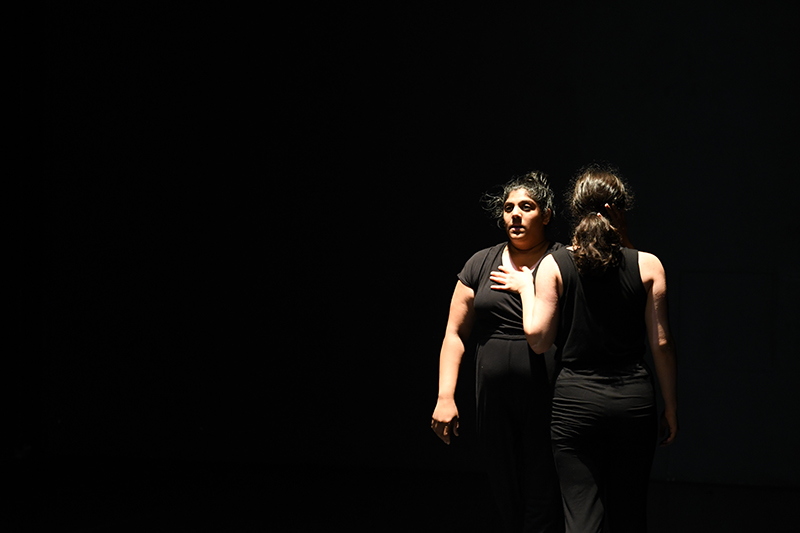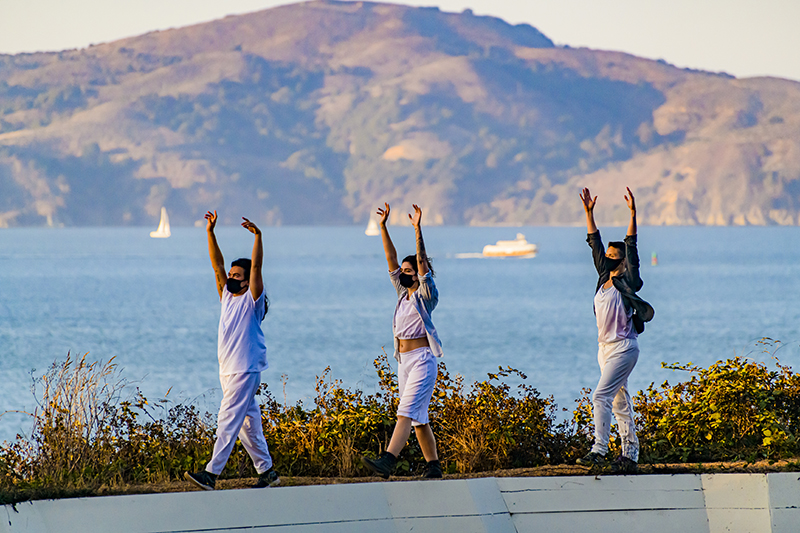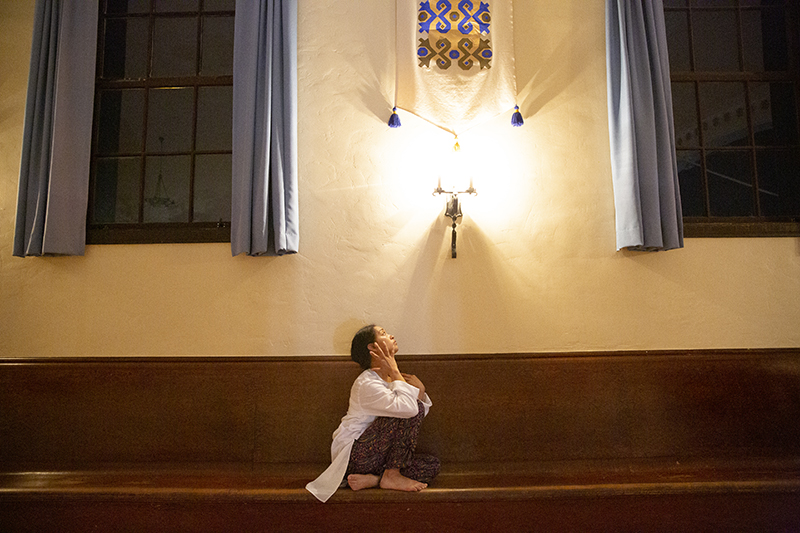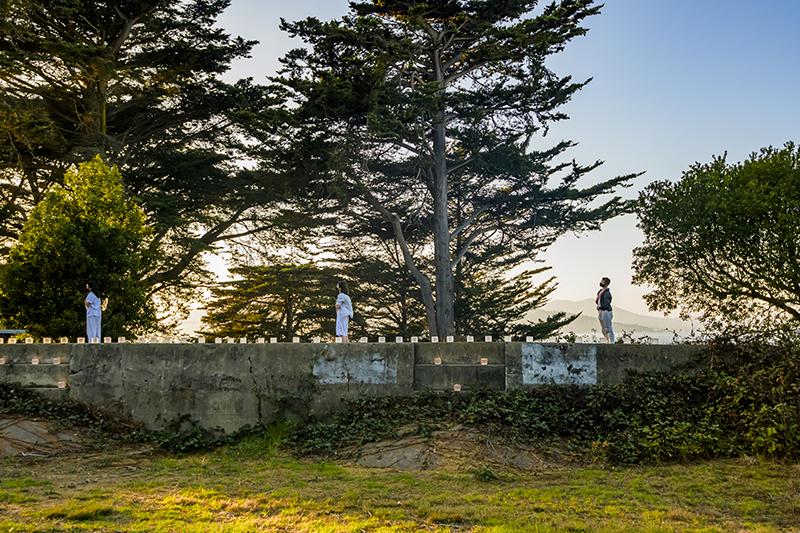in search of a decolonial performance praxis
BY BHUMI B PATEL
Note: This essay was first published in Stance on Dance’s spring/summer 2022 print issue. To learn more, visit stanceondance.com/print-publication.
Spoiler alert: I don’t have the answer and I’m suspicious of anyone who says they do.
Across and beyond the field of dance, there is a fascination with decolonization and decoloniality, and how to embody and enact these concepts by engaging theoretical frameworks with tangible action. From broad dialogues on decolonizing dance, to examining issues of decolonizing philanthropy, to even decolonizing stages and dance writing, the conversation is circulating through the field, and yet continues to be a ripe site for inquiry, particularly around performance practice. This endeavor to create a decolonized body is not one that any artist approaches alone, nor is being conducted in a singular way. In fact, many artists and theorists have attempted this ambitious undertaking: identifying approaches to explore these murky waters of decolonization in the space of settler colonization of the US.

Dancers: Bhumi B. Patel and Jordan Wanderer
Photographer: Douglas Calalo Berry
Performance: zero
As I write this, we have been navigating the COVID-19 global pandemic for 24 months. Two years. Though I hope this piece feels alive long after we leave this pandemic, I find that this period of life will certainly be blurry in memory and feel like an embodied reconceptualization of historical time. Maybe even queer time. Over this last year and a half, the work of reconceptualizing time has been at the forefront of our public discourses. We frequently talk about the “before times” and what life will be like when we “get back to normal” or “when COVID is over.” Yet, there is no back to return to. At least not for those of us at the margins.
The discourses around the decolonial have become louder and more visible during this pandemic, and because of this attention, I have been wondering what it means to engage with decolonial praxis in performance. For me, praxis is where practice and theory meet in informed, embodied, committed action. Perhaps to create decolonial performance praxis is to challenge the hegemonic histories of marginalization as a singular, forward-progressing trajectory that is divided into movements or waves or phases. Often this singularity leads to hegemonic viewpoints of timelines of liberation. This, in turn, misrepresents and curtails the ways in which liberatory practices and activisms can be related, conceptualized, and mobilized toward a point at which we never arrive. Perhaps a decolonial performance praxis centers the relationship between liberatory practices and activisms, moving us toward the unarrivable horizon. In Living a Feminist Life, Sara Ahmed suggests that when we are dismissed, like many experiences of oppressed people are, “we experience the world as all the more sensational; what is ordinarily overlooked or looked over appears striking” and that the “past is magnified when it is no longer shrunk” (40). Nothing has been discovered or rediscovered, it is just there and constant; the decolonial can allow space for magnifying a past that is acutely relevant. The past that is embodied in the work is experienced on a scale that is present and real in the here and now. It is magnified because it is no longer held back. The scale shifts, and thus we are shifted with it. Perhaps the decolonial is a shifted scale.
Perhaps time is queered in a decolonial performance praxis. As I continue to reflect on time, I wonder how artists at the margins exist outside of linear structures of time and what that looks like in performance praxis. I wonder about repetition, geologic speed, and continuous weight shifting to challenge linearity. I wonder about nonlinear storynests. Interwoven and messy. What else is possible to transgress structures of time? In Embodied Avatars: Genealogies of Black Feminist Art and Performance, Uri McMillan argues “time recuts, reverberates, and exceeds artificial distinctions between the past and the present. Time is polytemporal; what has come before is not contained in the past, but is continually erupting” (13) and that “black performance culture is ‘propagated by unpredictable means in non-linear patterns’” (200). These patterns are necessary as coding the process(es) of decolonial approaches to creating movement-based performance that pushes back against the structures of power that dictate so much of our ways of being and knowing.
When I have seen what I can identify as potential for decolonial praxis, I have felt an ever-growing sense of a nonlinear history, a tripping over the logics of linear time that afforded the past and present the opportunity to touch, even if just for a moment. Suzette Sagisi reflects on decolonizing the body by building off questions asked in the rehearsal process to outline her experiences with embodied feeling, intentionality, and decolonizing movement and what it felt like. She proposes that the body “decolonizes itself when it sheds what’s been forced upon it” and that “Black and brown movers decolonize themselves when they care for and center themselves, take up space, and move so that they may exist freely and fully” outlining what she holds to be at the center of decolonization of the body (Sagisi 2020). Sagisi’s use of the word “shed” indicates a type of unlearning the things that have been conditioned. These acts of world-creation in unlearning the colonial might get us closer.

Dancers: Daria Garina, Katherine House, KJ Dahlaw
Photographer: Kyle Adler
Performance: the long shadow
Walter Mignolo, in “Looking for the Meaning of ‘Decolonial Gesture’” asks the questions “What are decolonial ‘gestures? […] If ‘gestures’ are signs and if ‘universes of meanings’ are semantic frames, at what juncture could gesture be created or interpreted as decolonial?” (2014). Mignolo postulates that if we can understand gestures as movements of the body or limbs that are meant to be expressive, then a decolonial gesture “is a body movement which carries a decolonial sentiment or/and a decolonial intention; a movement that points toward something in relation to something already constituted that the addressed of the gesture or whomever sees the gestures, recognizes in relation to the ‘colonial gesture’” (2014). For Mignolo, “decoloniality is a complementary mode or even perhaps a successor to political decolonization,” and that “decolonization movements aim to overturn a system of colonial rule; decoloniality, by contrast, is an ongoing praxis that unmakes and reinvents techniques, institutions, and logics” (Spatz 2019, 16). The creation of this type of performance, one that reveals its own decolonial approach demonstrates that the intention of decoloniality is the ongoing praxis to unmake logics that tell us how we should move, and how we understand time itself. If it is ongoing praxis, I must have ongoing inquiries.
What does it mean to have a decolonial body?
What is being put on and what is being shed?
How do we tell the stories of our lives?

Dancer: Danielle Galvez
Photographer: Lydia Daniller
Performance: divisions the empire has sown
As I continue to think about how decolonial praxis can intersect with queer dance, I consider the ways that queerness and non-whiteness interact. But what is queer dance, and how can we be intentional about queerness in the racialized body? Here, I mean queer as in “being about the self that is at odds with everything around it and has to invent and create and find a place to speak and to thrive and to live” (hooks 2014). As dance scholar Clare Croft explains, queer dance is “a force of disruption” against the hegemonic or normative constructs that confine those on the margins. Croft recognizes “the links between dance and legacies of queer activism” and within these links, “‘queer’ signals a coalitional sensibility” and “draws on a more expansive notion of ‘queer,’ a broader challenge to social norms” thereby expanding outward from LGBTQ identities. Croft asserts that dance “has potential to have a particular power within queer work because dance emphasizes how public, physical action can be a force of social change.”
E. Patrick Johnson, in Black Queer Studies, offers that “because much of queer theory critically interrogates notions of selfhood, agency, and experience, it is often unable to accommodate the issues faced by gays and lesbians of color who come from ‘raced’ communities” (126-127). When I think through decolonial praxis for dance as queer dance, it can be about moving and relating to one another and self through a multitude of modalities, but that it requires the attention of decolonial praxis to address issues of communities of color. The work is queer in how it moves and creates relationships about one another and self through a multitude of modalities. I tread lightly on using queer dance because, as Gloria Anzaldúa cautions against, queer can be homogenizing and fail to recognize racial difference (Johnson 2005, 127). In this there is a tension that continues to evolve and at times dissipate, reflecting the tensions between our experiences themselves and the way in which the impacts of experiences change over time.
I wonder if there is a wildness to being free to both metaphorically and literally open our chests to the sky and ask to be carried through the portal toward liberation. I wonder if searching for decolonial performance praxis allows us to imagine how the orientations of time can shift and evolve with us over our, as Mary Oliver says, “one wild and precious life.”
Maybe we’re all just time travelers moving through time and space, bundled together past present future selves reaching out to find home.

Dancers: Daria Garina, Katherine House, KJ Dahlaw
Photographer: Kyle Adler
Performance: the long shadow
~~
References:
Ahmed, Sara. 2017. Living a Feminist Life. Durham: Duke University Press.
hooks, bell, Janet Mock, Shola Lynch, and Marci Blackman. 2014. “Are You Still a Slave?” The New School. May 6, 2014. Vimeo. 1:55:41. https://livestream.com/thenewschool/slave.
Johnson, E. Patrick, ed. 2005. Black Queer Studies. Durham: Duke University Press.
McMillan, Uri. 2015. Embodied Avatars: Genealogies of Black Feminist Art and Performance. New York: NYU Press.
Mignolo, Walter D. 2014. “Looking for the Meaning of ‘Decolonial Gesture’”. emisférica: Hemispheric Institute 11 (1). https://hemisphericinstitute.org/en/emisferica-11-1-decolonial-gesture/11-1-essays/looking-for-the-meaning-of-decolonial-gesture.html.
Sagisi, Suzette. 2020. “On Embodied Feeling, Intentionality, AND Decolonizing Movement.” HMD Blog, September 22, 2020. https://www.hopemohr.org/blog/2020/9/22/on-decolonizing-movement-embodied-feeling-and-intentionality.
Spatz, Ben. 2019. “Notes for Decolonizing Embodiment.” Journal of Dramatic Theory and Criticism 33 (2): 9-22.
~~
This essay began through reflection on Alexander Diaz’s performance work, “We’re Getting Closer.” The writing and performance were made possible through the generous support of Pepatián: Bronx Art Collaborative’s Dancing Futures: Artist & Mentor Collaborative Residency 2021, produced in collaboration with BAAD! Bronx Academy of Arts and Dance and funded by the Jerome Foundation.
Bhumi B Patel is a queer, desi artist/activist (she/they) and directs pateldanceworks. In its purest form, her performance work is a love letter to her ancestors. She earned her MA in American Dance Studies from FSU and her MFA from Mills College. Bhumi is currently a doctoral student at The Ohio State University. She is a member of Dancing Around Race, and engages with curatorial practices for both performances and written publications. Making art is her way of tracing the deeply woven connections in which we live–past, present, future–as a way to build communities of nourishment and care.
To learn more about Bhumi’s work, visit www.pateldanceworks.org.
This essay was first printed in Stance on Dance’s spring/summer 2022 print issue. To learn more, visit stanceondance.com/print-publication.
